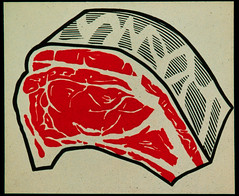Because I had gotten home a little early from work (even though I still had to do some work remotely), I took advantage of the extra couple of hours being home to make some white beans. I love beans in general, and generally try to cook them from scratch. This doesn’t really take that long, but it can be a little longer than many of us ware willing to wait on a regular weeknight. I’m a big fan of white beans so I decided to start some out. The secret to making good beans is to cook them slowly at barely a simmer. Cooking beans over a rolling boil will only lead to broken, exploded beans and won’t really take that much less time. I normally bring them to a boil and then turn them down to a bare simmer. If you see bubbles coming up, the heat is too high. Cooking them this way leads to great, creamy texture and illustrates why crock pots are so perfect for beans. Despite the opinions of some people, beans should be creamy and never al dente, but remember, creamy doesn’t mean mushy.
There’s a controversy about cooking beans with or without salt, because salt, and acidic ingredients, like tomatoes, can make beans tough, or cause them to take longer to cook. I normally cook my beans for a little bit of time with no slat, but like to add salt halfway through because beans need to absorb salt. Given a choice between salting them at the beginning or not at all, I’d take at the beginning. There’s anecdotal evidence in Mark Bittman’s How to Cook Everything, that the whole salt controversy is an old wife’s tale. He did experiments with two pots of beans, one with salt and one without salt, and found that after the same amount of cooking, one pot tasted seasoned and the other one didn’t.
He problem that I had this night was that the beans were cooked, in a few hours, but I really didn’t have any plan of what to do with them. By the time that the beans were done, nothing else was done and I had no plan. I had some vague idea of grilling something and serving it over a white bean salad but otherwise had no real idea. I asked my wife what she would like and got a response of “something with pesto since we have so much basil.” I still had the amazing fennel I had bought last weekend so I opted for another simple Mediterranean inspired dinner: grilled chicken breast with basil pesto served over white beans in a sherry vinaigrette with a fennel salad with a tomato vinaigrette on the side. Overall pretty simple if you have the beans cooked,
I made a sherry vinaigrette by chopping some shallots and garlic and letting them marinate in sherry vinegar with a little salt for about 10 minutes. Doing this helps to pull some of their flavor into the vinegar (it’s a trick I stole from an Alice Water/Chez Panisse cookbook). I added some olive oil and chopped parsley and then tossed it with the still warm, drained beans so they had a chance to absorb the dressing. The fennel was sliced on a mandoline and tossed with a tomato vinaigrette and some salt. The chicken breast was grilled over charcoal with salt and pepper and nothing else,
I was going to open a bottle of wine with this, but thought that the dual vinaigrettes may be too much for wine. I had a glass of homebrewed Belgian amber while cooking and opted to stay with beer. The Belgian amber is tough to compare with a commercial example. If I had I ad to find a rough comparison, I’d say it was like a Pauwel Kwak with more fruit esters (I’m not saying it’s as good as Kwak, I’m saying it’s similar in body and roughly in style.) This is a nice beer with a lot of things, but this didn’t seem a great meal for it. Instead, I pulled out a homebrewed Geueze. This one was a blend of 6 or different lots. It was about 15% three year old (from three different lots), 60% two year old (from two different lots), and 25% one year old (from one lot). These were the ages of the lots when it was bottled, but it’s been bottles for about 10 months now. It’s not as tart as most commercial Geuezes nor does it have the smoky, phenolic character of many, but it had great barnyard, peach and apricot, and citrus aromas and flavors. Despite being very dry, it had a very full, rich mouth feel. Because of its age it was brilliantly clear. It was tart enough to be a good match to the vinaigrettes, and in fact, helped to tame their acidity, but not so acidic as to clash with the fresh sweetness of the basil pesto. Another good match and further proof of lambic’s versatility with a wide variety of foods, and proof that you can make good lambic-style beers at home if you’re willing to blend and age the beers properly.
Thursday, July 19, 2007
More lambic and Mediteranean food
Posted by
Bill
at
5:43 PM
![]()
![]()
Subscribe to:
Post Comments (Atom)

No comments:
Post a Comment